Z2 × Z3 Equivariant Bifurcation in Coupled Two Neural Network Rings
Abstract
We study a Hopfield-type network that consists of a pair of one-way rings each with three neurons and two-way coupling between the rings. The rings have symmetric group Γ = Z3 × Z2, which means the global symmetry Z2 and internal symmetry Z3. We discuss the spatiotemporal patterns of bifurcating periodic oscillations by using the symmetric bifurcation theory of delay differential equations combined with representation theory of Lie groups. The existence of multiple branches of bifurcating periodic solution is obtained. We also found that the spatiotemporal patterns of bifurcating periodic oscillations alternate according to the change of the propagation time delay in the coupling; that is, different ranges of delays correspond to different patterns of neural network oscillators. The oscillations of corresponding neurons in the two loops can be in phase, antiphase, T/3, 2T/3, 4T/3, 5T/6, or 7T/6 periods out of phase depending on the delay. Some numerical simulations support our analysis results.
1. Introduction
The theory of spatiotemporal pattern formation in systems of coupled nonlinear oscillators with symmetry has grown extensively in recent years. Its impact has been felt in a wide variety of fields of applied science. Coupled networks of nonlinear dynamical systems have become important models for studying the behavior of large complex systems. These models allow us to investigate fundamental features of physical systems, biological systems, and so on. The central question is to understand how specific properties of the individual behavior and the coupling architecture can give rise to the emergence of new collective phenomena [1–5]. Couple can lead to oscillators’ synchronization, chaos, symmetric bifurcation, and so on [6].
Networks with a ring topology, where locally coupled oscillators or oscillatory populations form a closed loop of signal transmission, appear to be relevant for many practical situations. These systems sometimes show symmetric properties. In general, symmetric systems typically exhibit more complicated bifurcations than nonsymmetric systems, and as well they may increase the dimension of the space and the number of variables involved. Some bifurcations can have a smaller codimension in a class of systems with specified symmetries. Other bifurcations, on the contrary, may not occur in the presence of certain symmetries [7, 8].
Time delays have been incorporated into coupled models by many authors, since in real systems the signal inevitably propagates from one oscillator to the next over a finite distance and with a finite speed; a time delay can not be negligible. From the mathematical point of view, the presence of delays makes the problem harder to handle. In fact, the state vector characterizing a nonlinear delayed system evolves in an infinite dimensional functional space. Networks with interacting loops and time delays are common in physiological systems. For example, there are many interacting loops and feedback systems in the model of brain’s motor circuitry [9, 10].
In this paper, we focus on the simplest Hopfield network with delays. This model consists of two coupling unidirectional rings, each with three oscillators. See Figure 1.
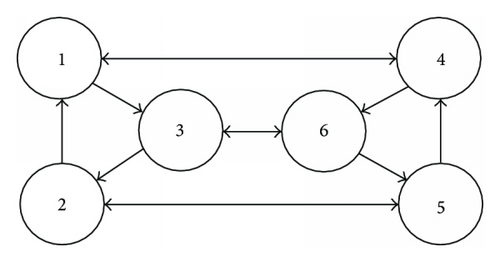
It is clear that (1) has symmetric group Γ = Z3 × Z2, which means the global symmetry Z2 and internal symmetry Z3.
In the next section we focus on the linear stability analysis of the trivial equilibrium. This then leads us to a discussion of the bifurcations of the trivial equilibrium. In Section 3, we present a characterization of all possible periodic solutions, their twisted isotropy subgroups, and corresponding fixed-point subspaces. We obtain some important results about spontaneous bifurcations of multiple branches of periodic solutions and their spatiotemporal patterns, which describe the oscillatory mode of each neuron. Finally, some numerical simulations are carried out to support the analysis results.
2. Elementary Analysis
Regarding τ as the parameter, we determine when the infinitesimal generator A(τ) of the C0-semigroup generated by linear system (7) has a pair of pure imaginary eigenvalues.
It is not difficult to verify that a + bi is a root of Δ2 = 0 or Δ5 = 0 if and only if a − bi is a root of Δ4 = 0 or Δ6 = 0.
-
(H1): |b − 1| < c;
-
(H2): |1 + (b/2)| < c.
If the assumptions (H1), (H2) hold, then the roots of Δ1 = 0, Δ2 = 0, Δ4 = 0, and Δ5 = 0 have negative real parts when τ = 0. In the sequel, we consider the distribution of zeros of Δ = 0.
Case 1 (Δ1 = 0). Let iω (ω > 0) be a zero of Δ1; then the critical frequency is identified as
Next, we consider the generalized eigenspace corresponding to pure imaginary eigenvalues of .
Let assumptions (H1) and (H2) hold such that (10) has roots ±iω1 when . Using Theorem 2.1 in [11], we have the generalized eigenspace consisting of eigenvectors of corresponding to ±iω1 is
Case 2 (Δ2 = 0). Letting iω (ω ≠ 0) be a zero of Δ2, then
For further analysis, we found that the transversality conditions are met:
The generalized eigenspace consisting of eigenvectors of corresponding to is
In a similar manner it can be shown that, for the fourth factor, Δ4 = 0, and fifth factor, Δ5 = 0, we have the following.
Case 3 (Δ4 = 0). In this case,
Case 4 (Δ5 = 0). Using the same method of case two, we have
3. Multiple Hopf Bifurcations
In the following, by discussing the isotropy subgroup and fixed-point subspaces, we will give the possible bifurcating solutions. From Section 2, we have obtained the generalized eigenspace corresponding to pure imaginary eigenvalues of . Hence, we know their corresponding isotropy subgroup; see Table 1.
| τ | Group action | Twisted isotropy subgroups | Fixed-point subspaces |
|---|---|---|---|
| ∑ (ρ, κ) | ς1(θ), ς2(θ) | ||
| ε1(θ), ε2(θ), ε3(θ), ε4(θ). | |||
| ∑ (ρ, −κ) | ς3(θ), ς4(θ) | ||
| ϵ1(θ), ϵ2(θ), ϵ3(θ), ϵ4(θ) | |||
The equivariant bifurcation theorem asserts the existence of branches of small amplitude periodic solutions to system (1), whose spatiotemporal symmetries can be completely characterized by isotropy subgroup.
- (1)
(x(t), x(t), x(t), x(t), x(t), x(t)).
- (2)
(x(t), x(t + (T/3)), x(t + (2T/3)), x(t), x(t + (T/3)), x(t(2T/3)));
- (3)
(x(t), x(t + (2T/3)), x(t + (4T/3)), x(t), x(t + (2T/3)), x(t(4T/3))).
- (4)
(x(t), x(t), x(t), −x(t), −x(t), −x(t)).
That means neurons in different rings are T/2 out of phase with each other, and all neurons are 2T/3 out of phase with the adjacent behaving identically in the same ring.
- (5)
(x(t), x(t + (T/3)), x(t + (2T/3)), x(t + (T/2)), x(t + (5T/6)), x(t(7T/6)));
- (6)
(x(t), x(t + (2T/3)), x(t + (T/3)), x(t + (T/2)), x(t + (7T/6)), x(t + (5T/6))).
In summary, we write the results in Table 2.
| Twisted isotropy subgroups ∑ | Periodic solutions |
|---|---|
| ∑ (ρ, κ) | (x(t), x(t), x(t), x(t), x(t), x(t)) |
| ∑ (ρei2π/3, κ) | |
| ∑ (ρei4π/3, κ) | |
| ∑ (ρ, −κ) | (x(t), x(t), x(t), −x(t), −x(t), −x(t)) |
| ∑ (ρei2π/3, −κ) | |
| ∑ (ρei4π/3, −κ) | |
4. Computer Simulation
To illustrate the analytical results found, in the following we consider the following particular case of (1).
Let b = −0.5, c = 2. Then , .
From Table 2, the spatiotemporal patterns of bifurcating periodic oscillations alternate according to the change of the propagation time delay. See Figures 2, 3, 4, 5, 6, 7, 8, 9, 10, 11, 12, and 13.
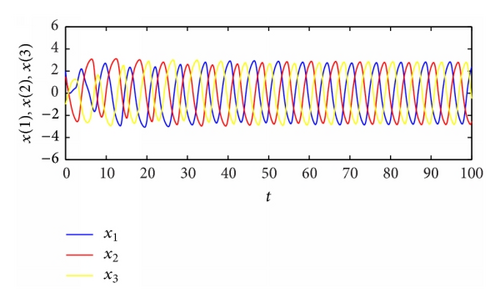
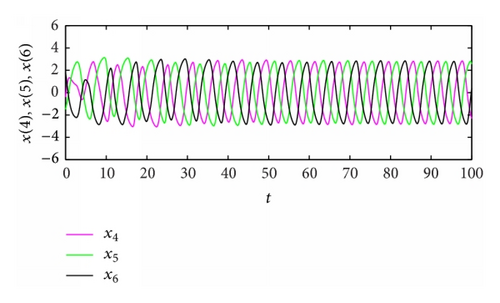
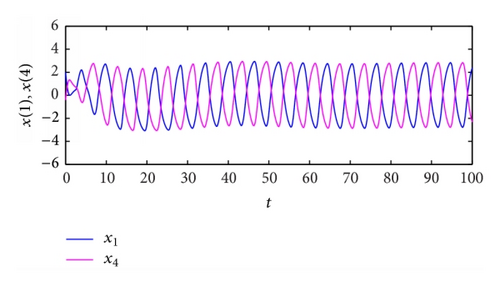
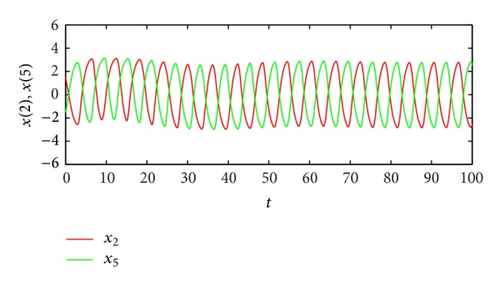
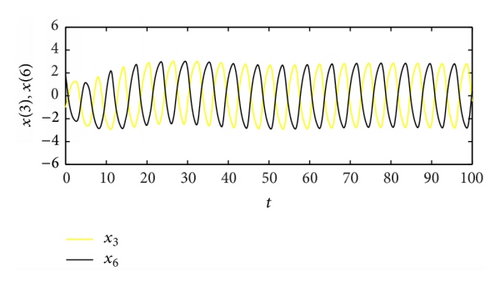
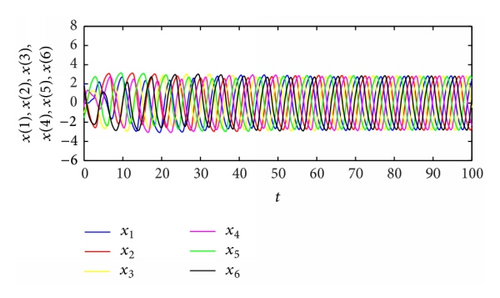
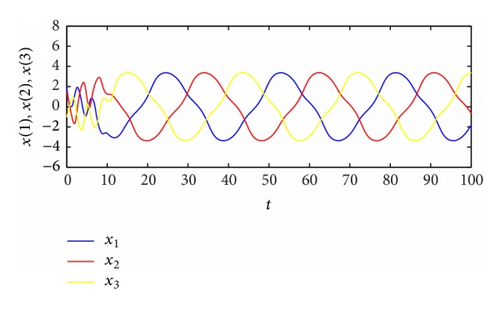
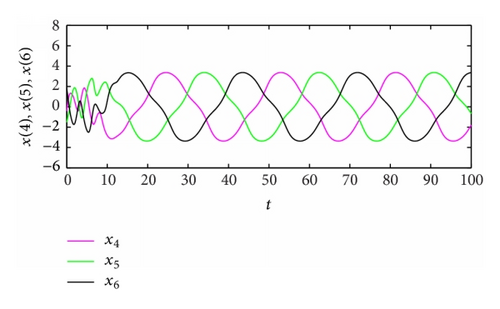
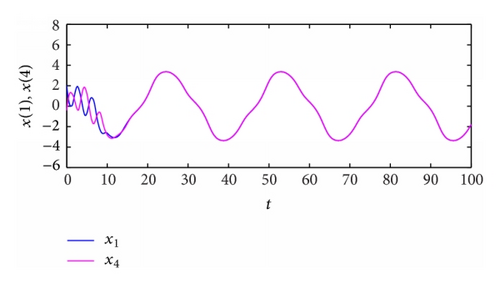
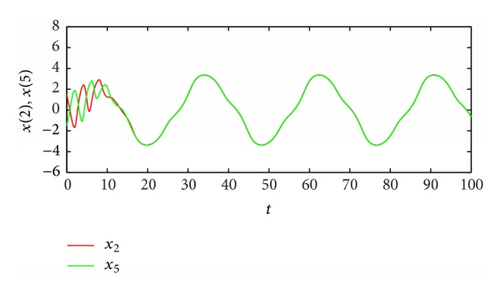
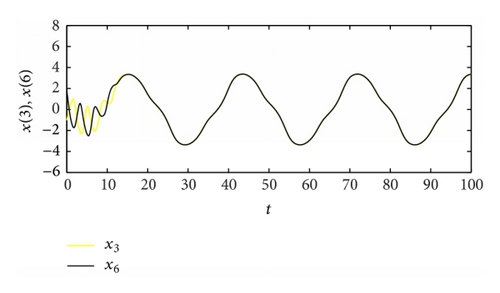
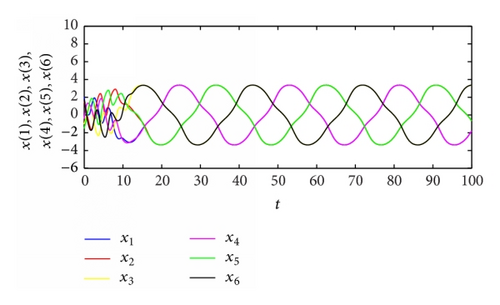
Conflict of Interests
The authors declare that there is no conflict of interests regarding the publication of this paper.




